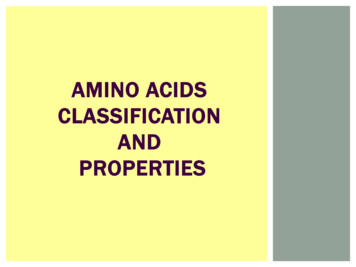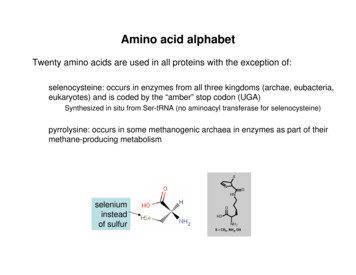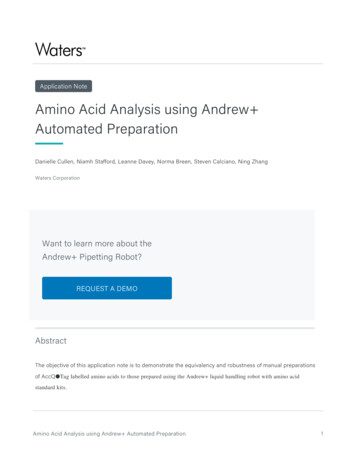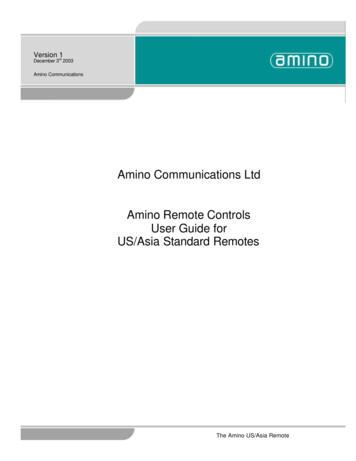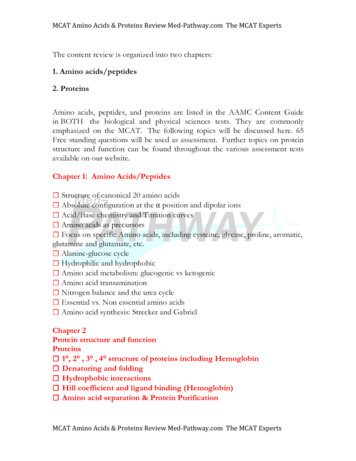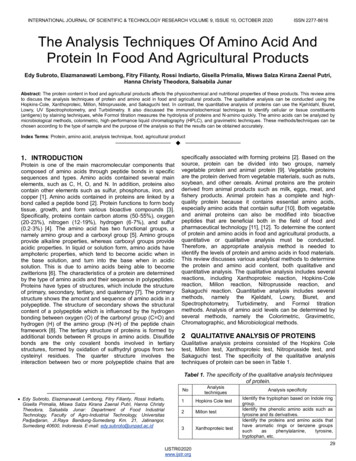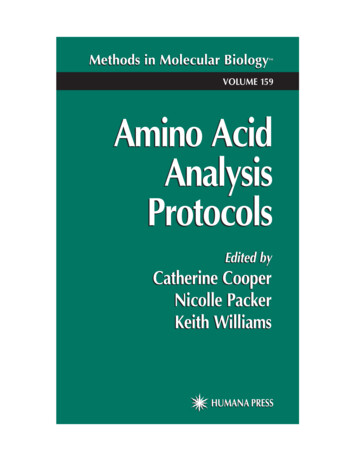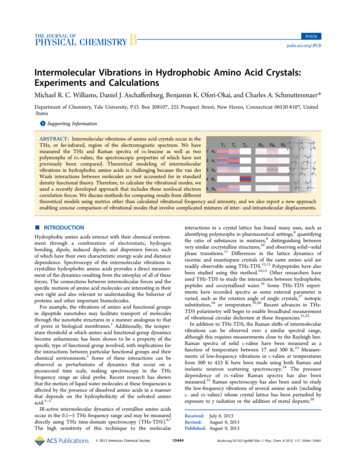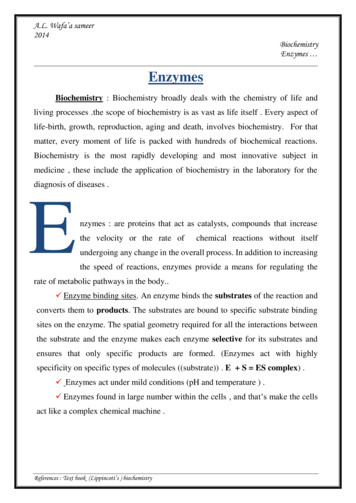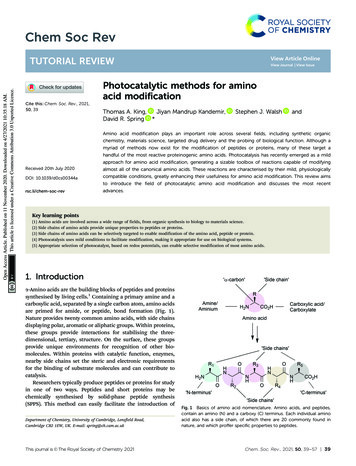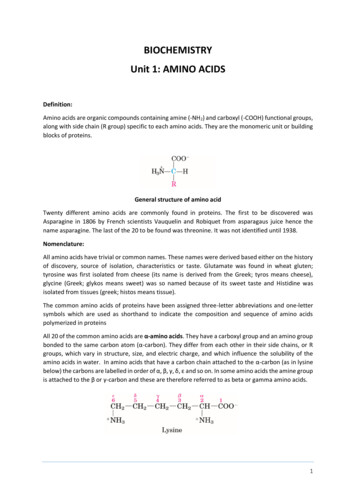
Transcription
BIOCHEMISTRYUnit 1: AMINO ACIDSDefinition:Amino acids are organic compounds containing amine (-NH2) and carboxyl (-COOH) functional groups,along with side chain (R group) specific to each amino acids. They are the monomeric unit or buildingblocks of proteins.General structure of amino acidTwenty different amino acids are commonly found in proteins. The first to be discovered wasAsparagine in 1806 by French scientists Vauquelin and Robiquet from asparagaus juice hence thename asparagine. The last of the 20 to be found was threonine. It was not identified until 1938.Nomenclature:All amino acids have trivial or common names. These names were derived based either on the historyof discovery, source of isolation, characteristics or taste. Glutamate was found in wheat gluten;tyrosine was first isolated from cheese (its name is derived from the Greek; tyros means cheese),glycine (Greek; glykos means sweet) was so named because of its sweet taste and Histidine wasisolated from tissues (greek; histos means tissue).The common amino acids of proteins have been assigned three-letter abbreviations and one-lettersymbols which are used as shorthand to indicate the composition and sequence of amino acidspolymerized in proteinsAll 20 of the common amino acids are α-amino acids. They have a carboxyl group and an amino groupbonded to the same carbon atom (α-carbon). They differ from each other in their side chains, or Rgroups, which vary in structure, size, and electric charge, and which influence the solubility of theamino acids in water. In amino acids that have a carbon chain attached to the α-carbon (as in lysinebelow) the carbons are labelled in order of α, β, γ, δ, ε and so on. In some amino acids the amine groupis attached to the β or γ-carbon and these are therefore referred to as beta or gamma amino acids.1
Structures of 20 Amino acidsClassification of Amino acids Classification based on the structure1. Aliphatic amino acid: Those amino acids whose ‘R’ group contains a chain of carbon atomsa. Mono amino mono carboxylici.Simple amino acids: Gly, Alaii.Branched chain: Val, Leu, Ileiii.Hydroxyl group containing amino acids: Ser, Thriv.Sulphur containing amino acids: Cys, Metv.Amide group containing amino acids: Asn, Glnb. Mono amino dicarboxylic acid: Asp, Gluc. Poly amino mono carboxylic acid: Arg, Lys2. Aromatic amino acids: Those amino acids whose ‘R’ group has a benzene ring Phe, Tyr, Trp3. Heterocyclic amino acids: The “R” group has a heterocylic ring, i.e., any of the ring structureswhich contain different atoms: Trp, His4. Iminoacid: Pro2
Classification based on the polarity of the R group1. Non polar amino acids: these are not soluble in water and thus hydrophobic in nature.They are Gly, Ala, Pro, Val, Leu, Ile, Met, Phe, Tyr, Trp2. Polar amino acids: these are soluble in water and thus hydrophilic in nature.They are Ser, Thr, Cys, Asp, Glu, Lys, His, Arg, Asn, Gln Classification based on the charge of the R group1. Acidic or negatively charged: Those amino acids that contain a negative charge or an acidicgroup-Asp, Glu.2. Basic or positively charged: Those amino acids that contain a positive charge or a basic groupArg, Lys and His.3. neutral Those amino acids that do not contain any charge on the ‘R’ group Classification based on nutritional value1. Essential or indispensable amino acids: are those which cannot be synthesized by the bodyand must be included in the diet. They are essential to the body for proper growth andmaintenance of the individualThey are Phe, Ile, Leu, Lys, Met, Thr, Trp, Val, His2. Non-essential: are those which can be synthesized by the body and may not be included inthe diet.They are Ala, Asn, Asp, Glu, Ser3. Semi essential: are those which can be synthesized but not in sufficient quantity therefore hasto be included. They are particularly essential in growing children, during pregnancy and forlactating mothers.They are Arg, His, Cys, Gly, Gln, Pro, Tyr Classification based on metabolic fate1. Glucogenic amino acids: these amino acids are used to synthesize glucose.They are Ala, Val, Ser, Thr, Gly, Met, Cys, Asn, Gln, Asp, Glu, His, Arg2. Ketogenic amino acids: these amino acids are used to synthesize ketone bodies.They are Leu, Lys3. Both glucogenic and ketogenic: these amino acids are used to synthesize both glucose andketone bodies.They are Ile, Tyr, Phe, Trp Classification based on whether used in protein synthesis or not1. Standard amino acids: these are used in the protein synthesis. Also called as proteinogenic.E.g., all 20 amino acids2. Non-standard amino acids: these occurs naturally in cells but not used in the protein synthesis.They are generated by modification of standard amino acids in the peptide molecule E.g., LDOPA, GABA3
Uncommon acids γ- carboxy glutamate: found in the blood clotting protein prothrombin.4- hydroxyl proline: a derivative of proline found in plant cell wall proteins, collagen5- hydroxyl lysine: derived from lysine found in collagen6-N-Methyllysine: a constituent of myosinDesmosine: derivative of four lys residues found in elastinThyroxine: iodinized derivative of Tyr found in thyroglobulin (thyroid gland)4
In addition to 20 standard amino acids, two more amino acids were identified that take part in theprotein synthesis. They are Selenocysteine and Pyrrolysine.Selenocysteine (Sec, U) is a cysteine analogue with a selenium containing selenol group in place ofsulfur containing thiol group. It is present in several enzymes for example glutathione peroxidase,glycine reductase.Pyrrolysine (Pyl, O) is an alpha amino acid that is used in the biosynthesis of proteins in somemethanogenic archea and bacteria. It is not present inn humans. Its pyrroline sidechain is similar tothat of lysine.Properties of Amino acidsGeneral properties Amino acids are colourless, non-volatile crystalline solids melting and decomposing attemperature above 200 CMost amino acids are soluble in water and insoluble in organic solvents.All amino acids except glycine are optically active.Amino acids (especially aromatic acids like phenyl alanine, tryptophan, and tyrosine) absorblight at characteristic wavelength. This spectroscopic properties can be used to measure itsconcentration in the unknown sample.All amino acids are amphoteric in nature. In the physiological pH, both carboxylic acid andamino group of α-aminoacids are completely iononized and therefore can act as an acid orbase. Substances with this properties are said to be amphoteric and may also referred to asampholytes.5
Optical propertiesFor all the common amino acids except glycine, α -carbon is bonded to four different groups: acarboxyl group, an amino group, an R group, and a hydrogen atom (in case of glycine, the R group isanother hydrogen atom). The α-carbon atom is thus a chiral center. Because of the tetrahedralarrangement of the bonding orbitals around the α-carbon atom, the four different groups can occupytwo unique spatial arrangements, and thus amino acids have two possible stereoisomers. Since theyare non-superimposable mirror images of each other the two forms represent a class of stereoisomerscalled enantiomers. All molecules with a chiral center are also optically active that is, they rotateplane-polarized light.Special nomenclature has been developed to specify the absolute configuration of the foursubstituents of asymmetric carbon atoms. The absolute configurations of simple sugars and aminoacids are specified by the D, L system. Based on the absolute configuration of the three-carbon sugarglyceraldehyde, a convention proposed by Emil Fischer in 1891. (Fischer knew what groupssurrounded the asymmetric carbon of glyceraldehyde but had to guess at their absolute configuration;his guess was later confirmed by x-ray diffraction analysis.)For all chiral compounds, stereoisomers having a configuration related to that of L-glyceraldehyde aredesignated L, and stereoisomers related to D-glyceraldehyde are designated D.Nearly all biological compounds with a chiral center occur naturally in only one stereoisomeric form,either D or L. The amino acid residues in protein molecules are exclusively L stereoisomers. D-Aminoacid residues have been found only in a few, generally small peptides, including some peptides ofbacterial cell walls and certain peptide antibiotics.Acid base propertiesWhen an amino acid is dissolved in water, it exists in solution as the dipolar ion, or zwitterion (Germanfor “hybrid ion”). A zwitterion can act as either an acid or proton donor (reaction a) or a base or protonacceptor (reaction b). Substances having this dual nature are amphoteric and are often calledampholytes.(a)(b)6
Amino Acids Have Characteristic Titration Curves. Acid-base titration involves the gradual addition orremoval of protons.The above figure shows the titration curve of the diprotic form of glycine. The plot has two distinctstages, corresponding to deprotonation of two different groups on glycine. Each of the two stagesresembles in shape the titration curve of a monoprotic acid, such as acetic acid and can be analyzedin the same way.At very low pH, the predominant ionic species of glycine is the fully protonated form, H3N-CH2-COOH.At the midpoint in the first stage of the titration, in which the -COOH group of glycine loses its proton,equimolar concentrations of the proton-donor ( H3N-CH2-COOH) and proton-acceptor ( H3N-CH2COO-) species are present.At the midpoint of any titration, a point of inflection is reached where the pH is equal to the pKa ofthe protonated group being titrated. For glycine, the pH at the midpoint is 2.34, thus its -COOH grouphas a pKa of 2.34 (labeled pK1 in Fig.). (pH and pKa are simply convenient notations for protonconcentration and the equilibrium constant for ionization, respectively. The pKa is a measure of the7
tendency of a group to give up a proton, with that tendency decreasing tenfold as the pKa increasesby one unit.)As the titration proceeds, another important point is reached at pH 5.97. Here there is another pointof inflection, at which removal of the first proton is essentially complete and removal of the secondhas just begun. At this pH glycine is present largely as the dipolar ion H3N-CH2-COO-.The second stage of the titration corresponds to the removal of a proton from the -NH3 group ofglycine. The pH at the midpoint of this stage is 9.60, equal to the pKa for the -NH3 group (labeled pK2in Fig.). The titration is essentially complete at a pH of about 12, at which point the predominant formof glycine is H2N-CH2-COO-.Keypoints:From the titration curve of glycine we can derive several important pieces of information.First, it gives a quantitative measure of the pKa of each of the two ionizing groups: (in case of Gly, 2.34for the –COO- group and 9.60 for the -NH3 group.)The second piece of information provided by the titration curve of glycine is that this amino acid hastwo regions of buffering power. In acidic solution, the COO- ion acquires a proton and the amino acidbecomes an ammonium salt of the acid. In alkaline solutions the NH3 loses a proton and the aminoacid becomes the anion of the salt.This is observed in the relatively flat portion of the curve, extending for approximately 1 pH unit oneither side of the first pKa of 2.34, indicating that glycine is a good buffer near this pH. The otherbuffering zone is centered around pH 9.60. (Note that glycine is not a good buffer at the pH ofintracellular fluid or blood, about 7.4.) Within the buffering ranges of glycine, the HendersonHasselbalch equation can be used to calculate the proportions of proton-donor and proton-acceptorspecies of glycine required to make a buffer at a given pHAnother important piece of information derived from the titration curve of an amino acid is therelationship between its net electric charge and the pH of the solution. At pH 5.97, the point ofinflection between the two stages in its titration curve, glycine is present predominantly as its dipolarform, fully ionized but with no net electric charge. The characteristic pH at which the net electriccharge is zero is called the isoelectric point or isoelectric pH, designated pI. It can be calculated usingthe following formula,pI ½ (pK1 pk2)At any pH above its pI it has a net negative charge and will move toward the positive electrode (theanode) when placed in an electric field. At any pH below its pI, glycine has a net positive charge andwill move toward the negative electrode (the cathode).(The farther the pH of a glycine solution is from its isoelectric point, the greater the net electric chargeof the population of glycine molecules. At pH 1.0, for example, glycine exists almost entirely as theform H3NOCH2OCOOH, with a net positive charge of 1.0. At pH 2.34, where there is an equal mixtureof H3NOCH2OCOOH and H3NOCH2OCOO, the average or net positive charge is 0.5. The sign and themagnitude of the net charge of any amino acid at any pH can be predicted in the same way).8
Chemical ReactionsReactions due to –COOH group1. Amino acid react with alkali like sodium hydroxide to give salt and water.Amino acidCorresponding Salt2. Esterification with alcohol, to give an amino ester.Amino acid3. Amino acids can be reduced to amino alcohol in the presence of lithium borotetrahydride orlithium aluminumhydride.9
4. Decarboxylation: Amino acids are decarboxylated to form corresponding amines. Trp isdecarboxylated to form tryptamine. Similarly, Phe becomes phe ethylamine; histidinebecomes histamine (this is involved in the local immune response; neurotransmitter); tyrosinebecomes tyramine; glutamic acid becomes gamma amino butyric acid. (GABA). It is animportant inhibitory neurotransmitter in central nervous system.5. Amino acids undergoes condensation to form its amides, this is important in the transport ofNH3 in the body.6. Amino acids react with hydrazine to form hydrazide. This is used to detect the C- terminalamino acid in proteins. It cleaves all peptide bonds and convert to their correspondinghydrazide except C-Terminal amino acid.10
Reactions due to –NH2 group1. Ninhydrin reaction: This is used as a color test to detect amino acids, also used in paperchromatography to visualise the separated amino acids. In forensics Ninhydrin is used todetect fingerprints because it reacts with amino acids from the proteins in skin cellstransferred to the surface by the individual leaving the fingerprint.11
2. Van slykes s reaction: it’s a method by which amino acids are measured upon the amount ofN2 released.3. Carboxylation: amino acids can be carboxylated to form its carboxy acids.4. With formaldehyde: amino acid react with formaldehyde to give monohydroxy (or N-hydroxy)methyl derivative. Further addition of formaldehyde yields dihydroxy (or N,N Bishydroxy)methyl derivative12
5. Amino acids combine with hydrochloric acid to give salt like NH3Cl6. Sanger reaction: amino acid react with 2,4 dinitro fluorobnzene (DNFB) or 1 flouro 2,4Dinitrobenzene (FDNB) or Sanger s reagent to give 2,4 dinitrophenyl derivative ofcorresponding amino acid. This was developed by Fredrick Sanger in 1945. It is used to detectN-terminal amino acid residue in protein sequencing.7. Edman reaction: amino acids react with phenyl isothiocyanate (PITC) under mildly alkalinecondition to give phenyl thiocarbamoyl derivative. This is less stable, so it forms a cyclicstructure called phenyl thiohydantoin derivative of corresponding amino acids. This reactionis used to detect N-terminal amino acids in protein sequencing.13
8. Oxidative deamination: an amino group is removed and corresponding α-keto acids areformed. This is converted to glucose or ketone bodies or completely oxidised.Reaction due to –SH groupCysteine is readily oxidized to form a covalently linked dimeric amino acid called cystine, in which twocysteine molecules or residues are joined by a disulfide bond. The disulfide-linked residues are stronglyhydrophobic (nonpolar). Disulfide bonds play a special role in the structures of many proteins byforming covalent links between parts of a protein molecule or between two different polypeptidechains.14
Qualitative tests for amino acidsSI. NOTESTREAGENTCOLOR1234Ninhydrin testXanthoproteic testLowry s reactionSakaguchi reactionpurpleYellowBlueRed5Millon s testRedTyr,Trp6Folin s testBlueTrp7Nitroprusside testRedCys89Lead acetate testHopkin s kole testVioletCysteine and CystineTrp10Pauly testRedTyr, His, Arg11Ehrlich testBlueTrp12Sullivan s testRedCys13Biuret testNinhydrin reagentBoiling Con. HNO3FC reagentAlpha naphtholSodium hypochoriteMillons reagent(Solution of mercuric sulfatein sulfuric scid)Alkaline phosphor molybdotungstic acidSodium nitroprusside in thepresence of excess NH4OHLead acetateGlyoxylic acid and con.Sulfuric acidDiazotized sulfanilic acidunder alkaline conditionpdimethylaminobenzaldehyde(DMAB)Sodium 1,2naphthoquinone-4sulfonate and NaOHAlkaline coppersulfateAMINO ACIDSRESPONSIBLEAll α-amino acidsTyr, Phe, TrpTyrArgBluedipeptideFunctions (or Importance) of amino acids1. They are the monomers of proteins. Amino acids are linked to each other by peptide bond toform proteins.2. Certain derivations of amino acids, especially of glutamate, are used as surfactants inmild soaps and shampoos. D-Phenylglycine and D-hydroxyphenylglycine are intermediatesused for the chemical synthesis of β-lactam antibiotics (e.g., synthetic versions of penicillin).Aspartame is a sweetener prepared from the individual component amino acids asparticacid and phenylalanine.3. Several α-amino acids (or their derivatives) act as chemical messengers. For example, γaminobutyric acid (gamma-aminobutyric acid, or GABA; a derivative of glutamicacid), serotonin and melatonin (derivativesof tryptophan),and histamine (synthesizedfrom histidine)are neurotransmitters. Thyroxine (a tyrosine derivativeproducedinthe thyroid gland of animals) and indole acetic acid (a tryptophan derivative found in plants)are two examples of hormones.15
4. Some amino acids (Glucogenic amino acids) are used as precursors to synthesizecarbohydrates.5. They act as buffers and it helps in maintaining the pH of the medium. As the pH increases itdonates H ions and as the pH decreases it accepts H ions6. Some amino acids serve as nitrogen storage. (Asn, Gln)7. Amino acids and their derivative help in nerve transmission, cell growth, biosynthesis ofpurines and pyrimidines.8. Some aromatic rings of Phe, Tyr, Trp help in electron transfer (in ATP synthesis).9. Our body uses the amino acids like Arg to make nitric oxide which helps lower the bloodpressure by relaxing muscles in our blood vessels.10. Under certain conditions amino acids can be metabolized for energy.11. Amino acids (proteins) function as biological catalyst.12. Amino acids are used therapeutically for nutritional and pharmaceutical purposes. Forexample L-dihydroxyphenylalanine (L-dopa) for Parkinson disease; glutamine and histidine totreat peptic ulcers; and arginine, citrulline, and ornithine to treat liver diseases.13. Several standard and nonstandard amino acids often are vital metabolic intermediates.Important examples of this are the amino acids arginine, citrulline, and ornithine, which areall components of the urea cycle. The synthesis of urea is the principal mechanism for theremoval of nitrogenous waste.14. Amino acids are precursors of a variety of complex nitrogen-containing molecules. Prominentamong these are the nitrogenous base components of nucleotides and the nucleicacids (DNA and RNA). Furthermore, there are complex amino-acid derived cofactors such asheme and chlorophyll. Heme is the iron-containing organic group required for the biologicalactivity of vitally important proteins such as the oxygen-carrying hemoglobin andthe electron-transporting cytochrome c.Chlorophyllisapigmentrequiredfor photosynthesis.16
The second piece of information provided by the titration curve of glycine is that this amino acid has two regions of buffering power. In acidic solution, the COO-ion acquires a proton and the amino acid becomes an ammonium salt of the acid. In alkaline solutions the NH 3 loses a proton and the amino acid becomes the anion of the salt.
